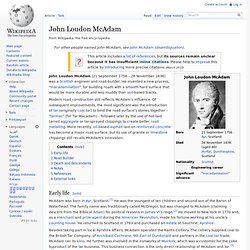

John Loudon McAdam. John Loudon McAdam (21 September 1756 – 26 November 1836) was a Scottish engineer and road-builder.

He invented a new process, "macadamisation", for building roads with a smooth hard surface that would be more durable and less muddy than soil-based tracks. Early life[edit] Besides taking part in local Ayrshire affairs, McAdam operated the Kaims Colliery. The colliery supplied coal to the British Tar Company, of Archibald Cochrane, 9th Earl of Dundonald and partners in the coal tar trade; McAdam ran its kilns. He further was involved in the ironworks at Muirkirk, which was a customer for the coke byproduct of the tar business. Road Builder[edit] Memorial stone to John Loudon McAdam. McAdam became a trustee of the Ayrshire Turnpike in 1783 and became increasingly involved with day-to-day road construction over the next 10 years. The macadam method spread very quickly across the world.
Death and descendants[edit] Notes[edit] References[edit] Devereux, Roy (1936). External links[edit] John McAdam. John Loudon McAdam was born in Ayr on 21st September, 1756.

His father was fairly wealthy but lost his money in a bad investment in a local bank. When he was fourteen he moved to New York City to work at his uncle's counting-house. His father's brother, William McAdam, had already established himself as a prosperous merchant. McAdam was taken into the home of this childless couple. After his uncle retired he took over the company. By 1778 he married Gloriana Margaretta Nicoll, the daughter of a wealthy lawyer. In 1798 the family moved to Bristol. In 1816 he was appointed surveyor to the Bristol Turnpike Trust. Brenda J. By 1819 the Bristol Turnpike Trustcontrolled 178 miles, and McAdam's salary had risen to £500 a year.
Gloriana McAdam died in 1825. John McAdam. Macadamizer(1756 - 1836) McAdams discovery came about when he started repair and maintenance work on the roads round his estate, which he bought after returning to the United Kingdom after making his fortune in America.

He had gone to New York at the age of sixteen and became an "agent for prizes" - an official form of dealing in stolen goods! Formal road construction started in Britain with the Romans who relied on heavy, carefully laid foundations to withstand the dual pressures of traffic and weather. The main difficulty with this system was that it was cumbersome to install and difficult to maintain.
McAdam's theory was that with a system of properly drained foundations bare, dry soil was strong enough to bear the weight of the type of traffic using the roads at that time. His system involved raising the road - bed with adequate drainage to carry away rainfall. John Loudon MacAdam. On his return to Scotland in 1783 MacAdam purchased an estate at Sauchrie, Ayrshire, and started experimenting with a new method of road construction.

When he was appointed surveyor to the Bristol Turnpike Trust in 1816 he remade the roads under his control with crushed stone bound with gravel on a firm base of large stones. A camber, making the road slightly convex, ensured the rainwater rapidly drained off the road and did not penetrate the foundations. This way of building roads later became known as the Macadamized system. As a result of his success, MacAdam was made surveyor-general of metropolitan roads in England. By the end of the 19th century, most of the main roads in Europe were built in this way. HOW often, when we walk or drive along our splendid English roads, do we consider the incredible difference between them and the roads of a century and a half ago? McAdam was born at Ayr on the 21st September, 1756.
McAdam Supervises Model Road Desire for Wider Interests. John Loudon McAdam History. John Loudon McAdam (British inventor. John Loudon McAdam - Building Roads. John Loudon McAdam - The History of Roads and Asphalt By Mary Bellis Return to the History of Roads and Asphalt John Loudon McAdam (born 1756) designed roads using broken stones laid in symmetrical, tight patterns and covered with small stones to create a hard surface.

McAdam discovered that the best stone or gravel for road surfacing had to be broken or crushed, and then graded to a constant size of chippings. John Loudon McAdam.